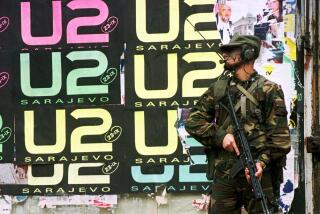Life During Wartime
- Share via
Even the most distracted visitor to the former Yugoslavia would notice the posters. I know I did. On the streets of Slobodan Milosevic’s Belgrade, they were ubiquitous. If you did not know the faces they depicted or the Cyrillic-lettered words emblazoned across them, you could not always tell if they were the handiwork of fascists or of anti-fascist activists. Maybe you felt uncomfortable looking at them. But you were compelled to. Maybe you needn’t be frightened. But they made you shudder. The colors were aggressive. The imagery was iconic and urgent. Whole walls were plastered with multiple copies of a single one.
Americans are not used to visual political propaganda of this nature. Bosnians, Croats and Serbs have been bombarded with it since the wars of the Yugoslav succession. Born of a powerful tradition of socialist poster art (associated above all with postwar Poland), the Yugoslav posters are stark, sophisticated and searing. Some of them stoke rage and fear; others portray solidarity and hope. Almost all of them play on words and symbols with wicked wit.
Of all the posters that came out of Yugoslavia’s last 10 years, those chronicling the pain and aguish of Bosnia from 1992 to 1995 have a chilling poignancy.
From posters that appeared in Bosnia during the war, Daoud Sarhandi and Alina Boboc have constructed a beautiful and terrifying book. Most of those they gathered are the work of Bosnian Muslims. Some are political: They urge young men to enlist; they equate Serbian nationalism with Nazism; they implore the international community to intervene. Others are elegiac: They memorialize the lost lives, the shattered cities, the country dismembered.
The most devastating, however, are the posters that give voice, color and shape to the hopes many Bosnians nurtured.
“Evil Doesn’t Live Here” takes its title from a defiant 1992 poster Sarhandi found in Tuzla. One reaches it after leafing through page after page of bullet holes, demolished buildings and portents of fascism. Then there is a sketch of the multiethnic city of Tuzla; above it, the words of the book’s title.
If you know nothing about the Bosnian war, “Evil Doesn’t Live Here” makes a superb primer. That was not Sarhandi’s and Boboc’s intention. But Sarhandi’s introduction provides one of the best overviews of the conflict’s history to be found anywhere. His captions lightly but expertly guide even a completely uninitiated reader through symbolism and events of great weight and complexity.
And then there are the posters. Through them we experience, nearly unmediated, the power of propaganda and the emotional resonance of political art in times of terror. The posters speak to us as though we were there--as though we might enlist or resist, as though we were neighbors and not strangers a world and a decade away.
More to Read
The biggest entertainment stories
Get our big stories about Hollywood, film, television, music, arts, culture and more right in your inbox as soon as they publish.
You may occasionally receive promotional content from the Los Angeles Times.










